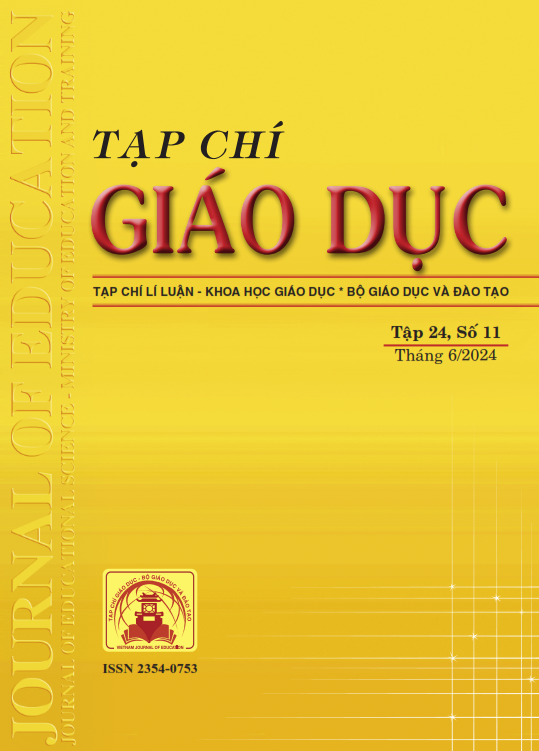Vấn đề thực tiễn trong dạy học mô hình hóa toán học ở trường phổ thông
Tóm tắt
Using mathematical modeling in teaching is an educational trend witnessed in many countries around the world as one of the most basic methods to develop mathematical modeling capacity for students. In high school, Mathematics proves to be a subject which provides plentiful opportunities to organize modeling-based teaching. However, the mathematical modeling process is only truly effective if learners have access to modeling situations (modeling problems). This study provides the concepts and techniques to classify practical problems in the mathematical modeling process as well as the basic process for teachers to design practical problems from a mathematical problem. Not every practical problem can be the starting point of the mathematical modeling cycle in teaching Mathematics in high schools, but that practical problem must be a real problem of social life discovered, selected, and edited by teachers to suit students' cognitive progress.
Tài liệu tham khảo
Abassian, A., Safi, F., Bush, S., & Bostic, J. (2020). Five different perspectives on mathematical modeling in mathematics education. Investigations in Mathematics Learning, 12(1), 53-65.
Arseven, A. (2015). Mathematical Modelling Approach in Mathematics Education. Universal Journal of Educational Research, 3(12), 973-980.
Berry, J., & Houston, K. (1995). Students using posters as a means of communication and assessment. Educational Studies in Mathematics, 29, 21-27.
Blum, W., & Niss, M. (1991). Applied Mathematical Problem Solving, Modelling, Applications, and Links to Other Subjects. State, Trends and Issues in Mathematics Instruction. Educational Studies in Mathematics, 22, 37-68.
Bora, A., & Ahmed, S. (2019). Mathematical Modeling: An Important Tool for Mathematics Teaching. Online Submission, 6(2), 252-256.
Bộ GD-ĐT (2018). Chương trình giáo dục phổ thông môn Toán (ban hành kèm theo Thông tư số 32/2018/TT-BGDĐT ngày 26/12/2018 của Bộ trưởng Bộ GD-ĐT).
Cao Thị Hà, Nguyễn Xuân Dung (2023). Phát triển năng lực mô hình hóa cho học sinh trong dạy học Hàm số ở lớp 10 trung học phổ thông. Tạp chí Khoa học Giáo dục Việt Nam, 19(03), 21-27.
Dong, T. H. N. (2019). The role of lecturers and factors affecting individual working competency of students at Thai Nguyen University-Vietnam through mathematical modelling process. In Proceedings of the 11th Asian Conference on Education (pp. 267-282).
Dundar, S., Gokkurt, B., & Soylu, Y. (2012). Mathematical modelling at a glance: a theoretical study. Procedia-Social and Behavioral Sciences, 46, 3465-3470.
Dương Hữu Tòng, Trần Văn Tuấn (2016). Dạy học bằng mô hình hóa toán học: Một chiến lược dạy học khái niệm logarit ở trường phổ thông. Tạp chí Khoa học, Trường Đại học Cần Thơ, 46, 62-72.
Erbas, A. K., Kertil, M., Çetinkaya, B., Cakiroglu, E., Alacaci, C., & Bas, S. (2014). Mathematical modeling in mathematics education: basic concepts and approaches. Educational Sciences: Theory and Practice, 14(4), 1621-1627.
Galbraith, P. L., & Clatworthy, N. J. (1990). Beyond standard models - meeting the challenge of modelling. Educational Studies in Mathematics, 21(2), 137-163.
Galbraith, P., & Stillman, G. (2006). A framework for identifying student blockages during transitions in the modelling process. The International Journal on Mathematics Education, 38(2), 143-162.
Garfunkel, S., & Montgomery, M. (Eds.). (2019). GAIMME - Guidelines for Assessment & Instruction in Mathematical Modeling Education. Society for Industrial and Applied Mathematics.
Gravemeijer, K. (2002). Preamble: From models to modeling. In K. Gravemeijer, R. Lehrer, B. Oers, & L. Verschaffel (Eds.), Symbolizing, modeling and tool use in mathematics education (pp. 7-22).
Dordrecht, The Netherlands: Kluwer Academic Publishers. Hidayat, R., & Iksan, Z. H. (2018). Mathematical modelling competency for Indonesian students in mathematics education programmes. Creative Education, 9(15), 2483-2490.
Kaiser, G. (2007). Modelling and modelling competencies in school. Mathematical modelling (ICTMA 12): Education, engineering and economics.
Lesh, R., & Doerr, H. M. (Eds.). (2003). Beyond constructivism: Models and modeling perspectives on mathematics problem solving, learning, and teaching. Lawrence Erlbaum Associates Publishers.
Lê Hồng Quang (2017). Vai trò của phương pháp mô hình hóa toán học trong dạy và học Toán ở trường phổ thông. Tạp chí Giáo dục, số đặc biệt tháng 3, 110-113.
Maaß, K. (2006). What are modelling competencies?. ZDM, 38, 113-142.
Nguyễn Danh Nam (2016). Phương pháp mô hình hóa trong dạy học môn Toán ở trường phổ thông. NXB Đại học Thái Nguyên.
Swetz, F., & Hartzler, J. S. (1991). Mathematical modelling in the secondary school curriculum. The National Council of Teachers of Mathematics: Reston, Virginia.
Voskoglou, M. G. (2006). The use of mathematical modelling as a tool for learning mathematics. Quaderni di Ricerca in Didattica, 16, 53-60.
Tải xuống
Đã Xuất bản
Cách trích dẫn
Số
Chuyên mục
Giấy phép

Tác phẩm này được cấp phép theo Ghi nhận tác giả của Creative Commons Giấy phép quốc tế 4.0 .












